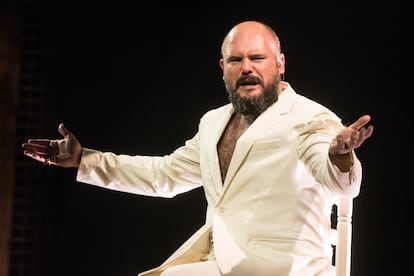Spanish-language music shakes off complexes and makes its mark on the global stage
In the United States, Latin music consumption registered a growth of 19.4 billion on-demand audio streams between 2021 and 2023, an increase of 24.1%

After decades of Anglo music reigning supreme, even in Spanish-speaking countries, Spanish has become the second-favorite language globally in terms of listening to music. According to a study by the Spanish Performers’ Association, sustained growth has led it to reach 62% of the music market in Spain. Luminate, the standard for measuring music sales, downloads and streams worldwide, estimates that, in the United States alone, Latin music consumption registered a growth of 19.4 billion on-demand audio streams between 2021 and 2023, an increase of 24.1% in that period. In terms of total number of audio streams, Latin music ranked second in growth, behind only country music, which grew by 20.4 billion streams.
Lourdes Hernández, better known as Russian Red, has been a direct witness to this exponential growth of Spanish-language music, and has even put it into practice on her first album with her own material in 10 years, Volverme a enamorar [Falling in Love Again], where she has abandoned English lyrics. “I’ve spent the last 11 years living in Los Angeles, where half the population is of Latino origin, so there’s a lot of Spanish-language music,” she says. “And with the momentum of urban music and reggaeton, the presence of music in our language has opened up a lot more.”

In her case, the duality between individual and artist has been definitive for the transition from English to Spanish. “I feel that when I sang in English as a child it had to do with a certain exoticism, with encoding the things that happened to me with a filter that almost turned me into another character, like a fantasy of myself,” she says. Switching to Spanish, she adds, “has to do with this exoticism, but in reverse. I have been living in Los Angeles for 11 years, I have an American husband, American friends, living a projection of who I was. Returning to Spain and using Spanish is like a fantasy in reverse.” The singer confesses she had always thought English had a more musical sound, but singing in Spanish has allowed her to find a place of her own, something very intimate, which in turn has contributed to her new album being more direct. “More than for the lyrics, for the attitude with which I interpret the songs, which is from a more visceral, sexier, more whispery place,” she says.
Russian Red is collaborating with other Spanish artists such as Bunbury, La Bien Querida or El Chojin in an Apple Music initiative that, on the occasion of Spanish Language Day at the United Nations, is celebrating Spanish-language music on April 23 by launching exclusive playlists created by the participating artists. Together, they offer a complete and emotional journey through the most inspired lyrics of Spanish music. The singer has put together a list that includes songs by Bola de Nieve, La Bien Querida or Rocío Jurado, with whom she feels an emotional closeness, but she highlights above all Mediterráneo, by Joan Manuel Serrat: “I think it’s unbeatable, worthy of a literature prize”, she says. “It’s a song with perfect lyrics and perfect music and melody, and it’s very difficult to do that.”

Another one of the guests is the flamenco-fusion artist Niño de Elche: “What they proposed was of interest to me, because I am a person who works with the Spanish language and I understood that I could contribute something,” he says. In his selection there is room for pieces that set to music the verses of the poets José Agustín Goytisolo, Agustín García Calvo and Antonio Machado, but also for songs by Esplendor Geométrico, Albert Pla and Los Planetas.
The artist admits his initial doubts about whether to include songs “written by poets in the strict sense of the word,” but decided to include them because “at the end of the day, they are songs.” Besides, he notes, all the compositions he has selected have a common characteristic: “I wanted songs that had a lot to say in Spanish... These songs form an idea of the language that is inseparable from the idea of Spain. There is a review of both the Spanish language and the idea of Spain, used in the broadest sense.”

Beyond heritage, traditions, and culture, the very particularities of each language dictate how easily it can be integrated into one musical style or another. The global boom of urban sounds born in Spanish-speaking countries, for example, allows a much greater natural integration of language with respect to those that originated in English-speaking countries.
Daniel Moisés Sáez Rivera, a professor in the Department of Spanish Language at the University of Granada, explains the phonetic difference between the two languages: “Spanish is a language of syllabic meter, and English, of accentual meter. This means that, in English, between each accent, the syllable tends to be cut or lengthened to maintain the rhythm, while Spanish maintains the length of the syllables.” According to Sáez Rivera, this makes English a very rhythmic language, with its facility for shortening syllables and vowels, while Spanish is more melodic and gives greater importance to rhyme. This makes, for example, the former “very good for rap.” In Spanish, he points out, “rap is very forced if it is not well done, because syllables are shortened and it is not easy to understand.”
Sign up for our weekly newsletter to get more English-language news coverage from EL PAÍS USA Edition
Tu suscripción se está usando en otro dispositivo
¿Quieres añadir otro usuario a tu suscripción?
Si continúas leyendo en este dispositivo, no se podrá leer en el otro.
FlechaTu suscripción se está usando en otro dispositivo y solo puedes acceder a EL PAÍS desde un dispositivo a la vez.
Si quieres compartir tu cuenta, cambia tu suscripción a la modalidad Premium, así podrás añadir otro usuario. Cada uno accederá con su propia cuenta de email, lo que os permitirá personalizar vuestra experiencia en EL PAÍS.
¿Tienes una suscripción de empresa? Accede aquí para contratar más cuentas.
En el caso de no saber quién está usando tu cuenta, te recomendamos cambiar tu contraseña aquí.
Si decides continuar compartiendo tu cuenta, este mensaje se mostrará en tu dispositivo y en el de la otra persona que está usando tu cuenta de forma indefinida, afectando a tu experiencia de lectura. Puedes consultar aquí los términos y condiciones de la suscripción digital.
More information
Archived In
Últimas noticias
Most viewed
- Reinhard Genzel, Nobel laureate in physics: ‘One-minute videos will never give you the truth’
- Pablo Escobar’s hippos: A serious environmental problem, 40 years on
- Charles Dubouloz, mountaineering star, retires at 36 with a farewell tour inspired by Walter Bonatti
- Why we lost the habit of sleeping in two segments and how that changed our sense of time
- The fall of a prolific science journal exposes the billion-dollar profits of scientific publishing










































